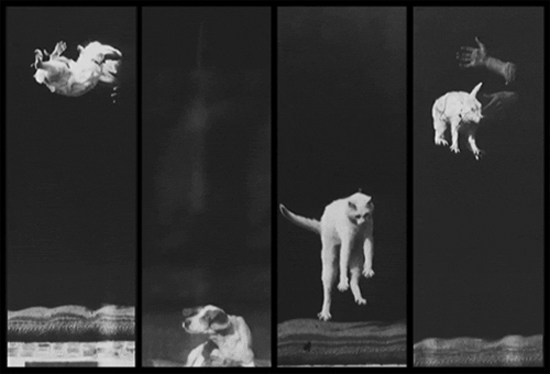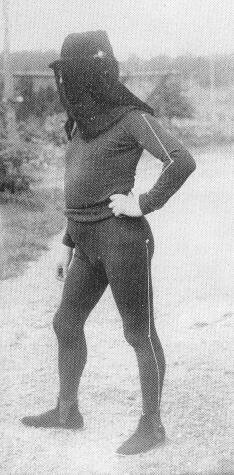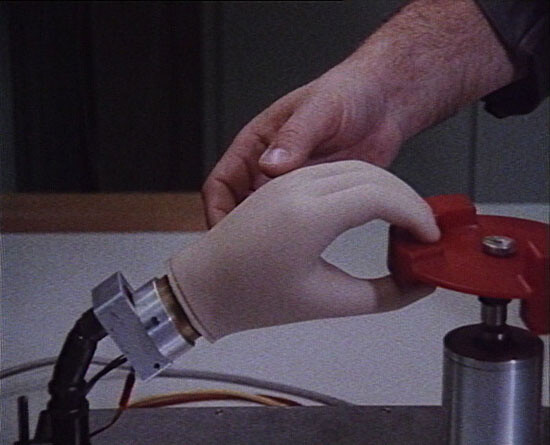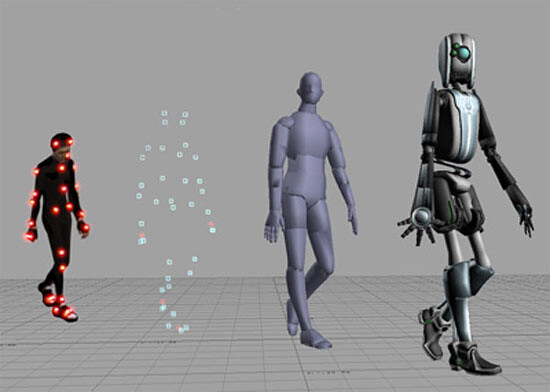In 2014, Harun Farocki was beginning work on a film project on Marey and Muybridge and the origins of cinema. The last thing I received from him was a DVD copy of a wonderful but obscure Thom Andersen film on Muybridge from the 1970s.
The body in movement: this project would have been a logical continuation of his work, an explication of a concern with “life” and its mobilization and reconstructibility that was already implicit in most of his films. More specifically, this new work would have drawn comparisons between the alliance of film, physiology, and the science of work that are at the origins of cinema, and the role that computer simulations and computer animation have assumed in reorganizing life (as well as the body and work) today.
A few years back, when Harun was beginning to draft the series Parallel, he was speaking of his interest in the technologies used in films like Avatar. In particular, motion-capture technology is somehow close to the techniques used by Marey: actors in special suits perform movements in spaces equipped with cameras and sensors. Human actors lend their gestures to what will later become a digitally animated character.


Indeed, the suits actors wear in motion-capture rooms recall those black suits with white points that were used in Marey’s physiological laboratory to track and dissect movements. As is well known, these physiological experiments not only led to the moving image, but were also foundational for an emerging science of work, for the rationalization of labor on the assembly line.


A typical scene from a Harun Farocki movie: a factory worker has to insert prefabricated parts into a machine for further processing. A study of the movements of both humans and machines. What is the worker doing? Why does this factory need her? It does not need her muscle power, nor her creative thinking, but only her cognitive ability to recognize the position of the parts that have fallen chaotically into a basket, and then grab them and align them anew with the machine. What kind of new machine could replace her? Rationalization on the assembly line, just like rationalization in war, depends on coming to terms with movement, complexity, and contingency, on linking recognition with movement. To this end, the machine has to learn how to “see.” “Seeing” here is detached from the labor of making a representation; it knows “recognition” only as a technical process of identification, in stark contrast to the meaning of recognition in human affairs and in politics. It is an a-subjective recognition in the best sense of the word.
Erhard Schüttpelz has suggested a useful distinction between “the complicated” and “the complex,” which helps to understand what is at stake in such a scene. According to Schüttpelz, “complicated” is anything whose operations can be computed, like train timetables. A conversation at a bar, however, is “complex”: it is ambiguous, and its many layers of meaning (and of animation) involve more factors than a simulation can easily take into account. The difference between the complex and the complicated was and continues to be the foremost frontier of modernization. By means of standardization and computation, modernity seeks to turn complexity into something that is merely complicated. War has been the prime engine of advance on this frontier.
Between Marey and motion-capture technology lies the twentieth century: the industrialization of death, and the victory of capital; technology in the service of the absolute negation of life, and the reconstruction of life as its inscription into what would be called the “social factory,” the subsumption of life under capital. Farocki was an observer and diagnostician of the enormous advance of technology into the realm of the complex (and hence life), and the link between this advance and the logic of production and war. At the same time, he was an observer of the collapse of distinctions, of the dialectical conflations of neoliberalism. On the one hand, the battlefield (which aspires to its own “hygiene” and “rational calculations”); on the other, the theater of training and rehearsing, simulating and modeling, through which capitalism penetrates “life.”
This scan of an actor’s face was developed by the Avatar CGI team in conjunction with the University of Southern California. Their objective was to produce Emily, a hyperreal CGI character modeled exactly after the real-life actor whose face enabled the scan.
Rather than being the “archeologist of images,” as he is often described, I learned to see Harun as first and foremost a documentarist whose work revolves around “life.” Certainly not in a vitalist sense, in some romantic or essentialist turn of mind, but in a non-reductionist way, as living, non-alienated labor, as dialogic force—life as something that upsets and disconcerts logic and the machine, but without ever affirming it as therefore entirely beyond logic or the grasp of concepts or imagery. To the contrary, life is actualized in form, in images, in concepts.
To me, Harun’s work always appeared as a critique of animation, of the modes of animation and subject-production that pertain to industrialism. But this critique rarely targeted the phantasms of popular fiction directly (although sometimes it did); rather, it was directed at the “magic“ that he identified in the seemingly inconspicuous representations of purely operational processes. Such a dialectical inversion resounds with Benjamin, and indeed I was often tempted to see films like Between Two Wars or As One Sees as a realization of what Benjamin demanded from the Surrealists in 1929, namely, that they exchange “the play of human features for the face of an alarm clock that in each minute rings for sixty seconds.”
“Life” in Harun’s world and work is diagnosed like a patient in critical condition. I would call the diagnosis “clinical positivism,” a monitoring of life-systems at their critical margins. Capital’s solution to the crisis of the absolute negation of life, it turns out, was its techno-social reconstruction. The patient had to be reanimated, and in the course of this reanimation (and thus de-alienation and de-objectification), the oppositional matrix of the disciplinary society had to be undone. What followed from this was the well-known collapse of dichotomies, which Harun captured like few others. When he analyzed the links between production and war, it was by way of an emphatic immersion in its logic, a dialectics that put itself permanently, and empirically, at risk. He then became a technician, one who relied, to paraphrase Benjamin, on an action to “put forth its own image”—“as if the world itself wanted to tell us something.” But when he portrayed the absurd theater of the grand de-alienation of neoliberalism, he was not only truly Brechtian; he also delineated how desire, the dream of transformative mobility, and psychic life as such had turned into a resource. The way people now had to “put forth their own image” demanded a rather different response.


This is why the image of the motion-capture technique used in Avatar matters. This image, showing the actor in the lab and the resulting digital character next to each other, is an image of the production of images, and it represents the solution that was applied to the “problem” of the technological negation and subsequent reconstruction of life. It is an image that is paradigmatic for our current moment: humans pushing machines across the uncanny valley, beyond the winter of artificial intelligence. The winter of artificial intelligence: this refers to a period of several decades in which AI and robotics failed to fulfill the horizon of expectations in reconstructing and automatizing life. It describes the temporary inability of the machine to cross from the merely complicated into the realm of the dynamically complex. The winter of artificial intelligence: an allegory, also, for the reductionist, militaristic reality principle of an “administered life.” But above all, it was a “problem” at the junction between technology and imagery, one that demanded to be solved.


The solution is represented in the image of motion-capture technology. Harun spoke of how digital animation hit a limit (not unlike the “winter of artificial intelligence”) when it tried to reconstruct the human walk (again referring us back to Marey). It always looks mechanical, and never organically alive. Not only is it cheaper to use real actors in motion capture than to produce characters from scratch in digital animation, it is also the way to ensure that technology today has always-already been pushed beyond the uncanny valley, because that valley itself is now bridged by the investment of life into machines. In augmented realities, “intelligent environments,” and “self-learning systems,” the organic and the machine have formed intricate networks. Living beings now supplement the machine and provide it with that part of animate intelligence which to date it has not been able to (re)produce by itself.
Thus, the “frontier” between the complex and the complicated has transformed: the complicated now “accommodates” and “frames” the complex, by monitoring its flows and registering any deviations from the “patterns of life,” using them to expand their scope by means of generative algorithms. Harun referred to the data maps of operational computer animations that are used to monitor complex systems—from factories to cities to battlefields—as “ideal-typical” images, images that seek to outperform cinematographic and photographic representations, and indeed the reality of life itself. Reality is then no longer the measure of an always imperfect image. Instead, the image increasingly becomes the measure of an always-imperfect reality. It was this inversion that Harun’s work never failed to put back on its feet.
